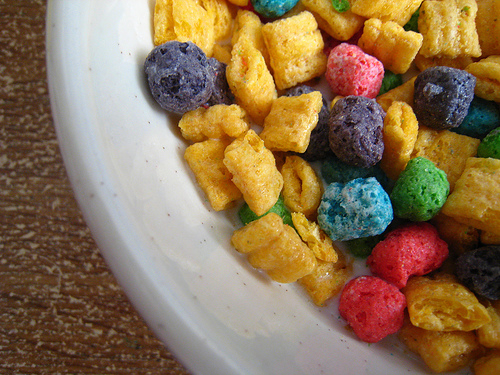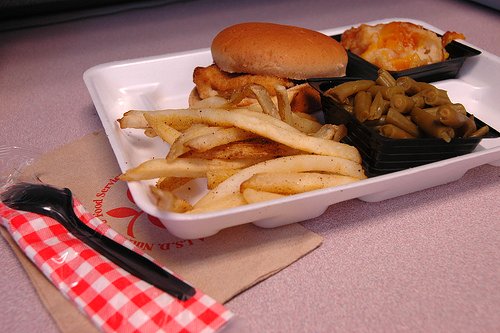Ed Bruske recently spent a week in the kitchen at H.D. Cooke Elementary School in the District of Columbia observing how food is prepared. This is the fifth of a six-part series of posts about what he saw. Read parts 1, 2, 3, 4, and 6. Cross-posted from The Slow Cook. And check out the rest of the Cafeteria Confidential series.
 Photo: Flickr via bookgrlOne unfortunate aspect of the sewer system design here in the District of Columbia is that in large swaths of the city it connects with the same pipes that carry storm runoff. Thus, when we get a heavy rain in the nation’s capitol, raw sewage flows underground past the capital dome and right into the Anacostia River.
Photo: Flickr via bookgrlOne unfortunate aspect of the sewer system design here in the District of Columbia is that in large swaths of the city it connects with the same pipes that carry storm runoff. Thus, when we get a heavy rain in the nation’s capitol, raw sewage flows underground past the capital dome and right into the Anacostia River.
Needless to say, the Anacostia, which flows into the Potomac not far from the Jefferson Memorial, does not see a lot of bathers.
When architects began planning renovations to the 100-year-old H.D. Cooke Elementary School building a few years ago, one of the things they focused on was a way to prevent rain water from flooding the sewer line. Huge holes were dug on the school grounds and into them were placed holding tanks the size of tractor trailers. The purpose of the tanks is to hold the water so that it doesn’t flood the storm drain system and cause a discharge of raw sewage. The water is released slowly. The tanks are also equipped with filters to remove oil and grease and other pollutants that wash off paved areas.
The rain water capture system was just one of many “green” features in the $35 million school rehab. Prior to the renovations, windows were so decrepit they were falling into the classrooms. The school got all new insulated windows that also filter ultra-violet rays. Special care was taken during demolition to recycle old drywall and other building materials. To save water in the new school, the boys bathrooms were fitted with waterless urinals; new toilets have a water-saving liquid or solid flush option. To economize on electricity, lights were equipped with motion sensors, windows were designed to make maximum use of daylight. To hold down heating and cooling costs, and to maintain healthy, comfortable air quality inside the building, special monitors and fans and ventilation systems were built.
When our daughter enrolled at the school this past fall, we simply marveled at the facilities: the brand new gymnasium and cafeteria, the gem of a library, the computer rooms lined with sleek new monitors and keyboards, classrooms filled with new furniture. It was a far cry from the ancient schoolhouse a few blocks away where our daughter had been attending charter school. Little did we suspect that behind all the improvements, the food service operation at H.D. Cooke would be turning this “green” school into an enviro hog.
Also included in the renovations was a new school kitchen. Walk-in freezer and refrigerator, convection ovens, steamers, holding cabinet, stainless pot sinks and work benches — it’s all there. But if you’re a chef with a crazy fascination with commercial kitchen equipment like me, you also notice right off that there is no dishwasher in the H.D. Cooke kitchen. And that’s because there are no dishes to wash: other than the tables the kids eat off, everything about the cafeteria operation is disposable.
One wag has said that the most important tool in school kitchens these days is a box cutter. During the week I was there as an observer, there were days when the boxes that frozen and canned foods arrived in grew into a pile near the door to the loading dock. Pizza, chicken nuggets, hamburger patties, tater tots — from factories around the country, it all comes sealed in plastic bags inside cardboard boxes. The empty boxes made it easy for me to read and copy ingredient labels into my little reporter’s notepad. But what happens to all those boxes after that?
According to D.C. Councilmember Mary Cheh (D-Ward 3), author of “Healthy Schools” legislation now pending before the Council, about two-thirds of D.C. Public Schools and most charter schools do not recycle. Even at DCPS schools that do recycle, waste from food service is neither recycled nor composted.
Practices in the cafeteria reflect the drive for convenience and lower labor costs. Just as food preparation is engineered to be quick and easy, using lots of pre-cooked frozen meal items, food service has been designed to require the least amount of human intervention. Disposable plastic rules. Kids bus the tables themselves. The only thing that comes back to the kitchen is the uneaten food from the steam table, and that is simply flushed down a commercial-size garbage disposal.
When students enter the food line, or “Kid’s Stop Cafe,” they pick up a non-recyclable Styrofoam tray that doubles as a plate. At breakfast they choose from Pop Tarts and Goldfish “Giant Grahams” wrapped in foil. Individual servings of cereal come in plastic tubs with plastic seals. Fruit juice is distributed in 4-ounce plastic containers with foil seals. Eating utensils are displayed in individual plastic packaging: a plastic spoon that’s also a fork — known affectionately as a “spork” — a plastic drinking straw and a paper napkin.
Drink cups are unnecessary. Besides fruit juice, the only other beverage in the cafeteria is milk. All of the students take milk with breakfast and lunch and drink it directly out of the disposable carton it comes in.
Students sit at tables in the large dining hall eating off their Styrofoam trays, drinking their milk. As they finish, they’ve been trained to walk their trays over to one of the large trash cans at the other side of the hall and drop it in. Everything from the meal service — foil packaging, plastic tubs and cups, milk cartons, spoons, napkins, Styrofoam trays — soon joins the cardboard boxes and plastic bags and industrial-size cans from the kitchen in a dumpster to be hauled off to a landfill.
Do the math and the amount of trash becomes scary. H.D. Cooke serves about 150 students for breakfast and another 280 for lunch. That’s 430 Styrofoam trays every day, five days a week, nine months a year. Styrofoam, the brand name for petroleum-based polystyrene, is light as a feather yet practically impervious to the usual forces of decomposition — no one can be sure how many hundreds of years it might take to break down in the environment. And this is just one school. There are some 40,000 kids enrolled in the D.C. Public Schools, and another 20,000 in public charter schools.
The environmentally unfriendly nature of school food service poses a number of obvious contradictions. Signs around the school, hand-drawn by students, extol the importance of being kind to the planet. My daughter, who attends fourth grade at H.D. Cooke, is a member of the school’s “green team.” Every week, she says, the “green team” members patrol the school, handing out $1 citations to people who leave their lights on or forget to turn off the computers. But in the lunch room, she and all the other kids are filling trash cans twice a day with mounds of non-recycled refuse.
Under the “Healthy Schools” bill, all DCPS schools, including food service, would be required to recycle paper, bottles, cans, and cardboard, but only “when funds become available.” Schools would also be required to compost food waste, and the bill calls for a pilot composting program that would involve schools as well as the city’s departments of public works and the environment. But again, provisions would only apply “once funds were appropriated.”
As for the Styrofoam and all the plastic entailed in school meals, “Healthy Schools” would require that schools switch to “sustainable products” within four years. At what cost remains to be seen.
Next: Conclusions



